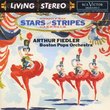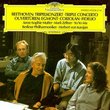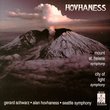Can hold its own with the best (if it isn't the best)
MartinP | Nijmegen, The Netherlands | 08/31/2003
(4 out of 5 stars)
"By any standards, this is an uncommonly beautiful and deeply satisfying account of this difficult, potentially disjointed piece. Several factors contribute to this. A notable one is Salonen's refusal to linger over passages that betray their limited staying power under the baton of more indulgent conductors. Thus, the post horn serenade in the third movement for once doesn't outstay its welcome. The bizarre juggernaut of the first movement is also kept moving along at an energetic marching tempo, its paragraphs joined by clearly articulated drum solo's instead of the usual vague rumblings that made you suspect the composer simply didn't know how to get from A to B. The final pages of this movement are indeed 'drängend', as Mahler requests, and to spectacular effect! In the second and third movement Salonen may at times be a bit too flexible with his tempi, inserting a few big ritenuto's where none are asked for, or defying the ones Mahler wants, playing them a bar later or earlier or not at all. Instances of this are to be found in the second movement especially. Nevertheless the fairy tale atmosphere of these pieces is realised to perfection. The post horn sounds duly distant, and the enlarged final ff return of its theme in the horns is magical, replete with rippling harps and quivering strings, truly otherworldly!
The Zarathustra song may be a bit too brisk for some, but it works nevertheless - even though Anna Larssons's (beautiful) singing is not at all 'durchaus leise'. The fifth movement is fresh, lightweight and folksy as it should be (the boy choir may be a bit polished or even timid to some tastes, but to me seems far preferable to Bernstein's bellowing NY street gang on DG). And the adagio really leaves almost nothing to be desired: it unfolds with all the unhurried majesty it requires and in this even more than in other movements one is stunned at the sublime playing of the LA Orchestra. The combination of precision with beauty of tone and occasional individual touches of phrasing and expression is indeed breathtaking!
There is an unfortunate and unnecessary letdown right at the end, though. I'm at a loss to understand what prompted the folly of reinforcing the final five timpani strokes with loud thwacks on the bass drum. This peculiar retouching of Mahler's score seems out of character with this conductor, and the cheaply sensational effect it achieves certainly doesn't match the composer's demand for a 'noble, saturated tone, not brute force'. Salonen demonstrates that he DOES know what Mahler meant even in the final chord, which is not extremely loud, but notated as a mix of f and ff levels, and duly rendered that way.
To top it all off, the recorded sound is very pleasing indeed. It is not extremely detailed, but has the atmosphere of a real-life concert, with woodwinds somewhat recessed, lower dynamic levels up to mf or even f sounding fairly mild, but with louder passages opening up impressively. In this, it is similar to the Inbal recording on Denon, though it sounds less distant and miniaturised than that. Incidentally, it also shares with that recording (and very few others) a clearly articulated, realistic sounding bass drum. All bass lines are marvellously sonorous for that matter, and a further help to textural clarity is the left-right division of first and second violins (which is what Mahler would have expected!).
On the whole, this is a very strong contender in a field without clear first choices. I long cherished the Haitink version from Berlin, but on recent rehearing it struck me as rather unvaried and severe (and I was surprised to note several wrong entries). Yet, I will keep listening to it for Jard van Nes's singing alone - her astounding rendering of the fourth movement has never been equalled by another singer. Bernstein on DG offers what is probably the best version ever of the first movement, but the rest is crude and uniformly loud, making it the most disappointing issue in his last Mahler-cycle. Inbal is quite good, though his orchestra is not up to the standards set by others. Older recordings tend to sacrifice too much of the work to inadequate recording technique - and this is a hifi symphony if ever there was one! I am curious about the recent Boulez, and am eagerly looking forward to Chailly's Concertgebouw recording, due to be issued soon by Decca. Until then, I will be listening to Salonen a lot!"
Outstanding
asiafish | Los Angeles, CA United States | 05/02/2002
(5 out of 5 stars)
"Last month I had the pleasure to attend Mr. Salonen conducting Mahler's Das Klagendelied, and was so moved by his performance of a work by my favorite composer, that I sought-out this recording.Mahler's 3rd Symphony is a complex piece, which along with his 2nd Symphony, transports the listener through a journey of discovery and change. The music begins in both pieces with a dark mood, and remains true to it throughout. This is not a light work for a casual listener, but rather heavy, dark and powerful music which both demands and rewards attention.Salonen's performance here is beyond reproach, and has replaced Jascha Horenstein's early 1980s recording as my favorite Mahler's 3rd. Now if only Sony Classical would release that March, 2002 performance of "Das Klagende Lied"."

![header=[] body=[This CD is available to be requested as disc only.]](/images/attributes/disc.png?v=430e6b0a)
![header=[] body=[This CD is available to be requested with the disc and back insert.]](/images/attributes/disc_back.png?v=430e6b0a)
![header=[] body=[This CD is available to be requested with the disc and front insert.]](/images/attributes/disc_front.png?v=430e6b0a)
![header=[] body=[This CD is available to be requested with the disc, front and back inserts.]](/images/attributes/disc_front_back.png?v=430e6b0a)

 Track Listings (15) - Disc #1
Track Listings (15) - Disc #1








